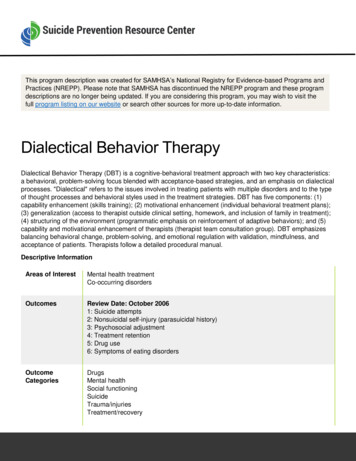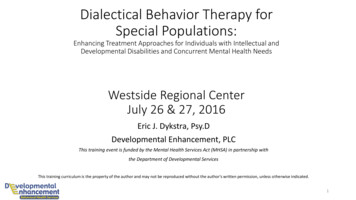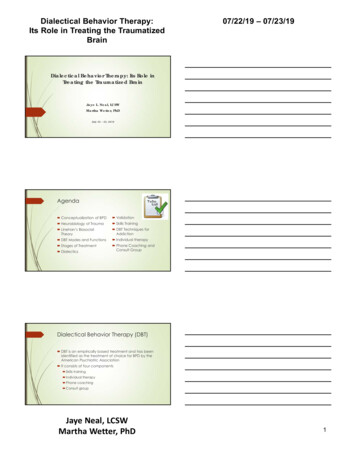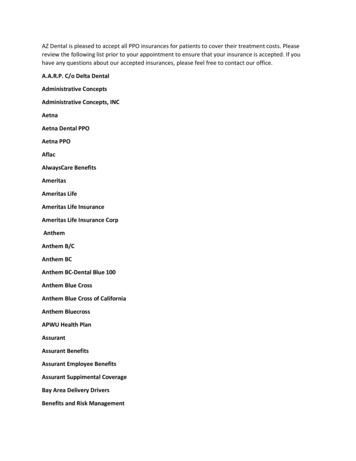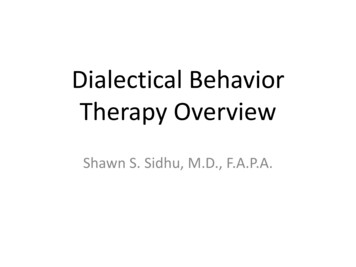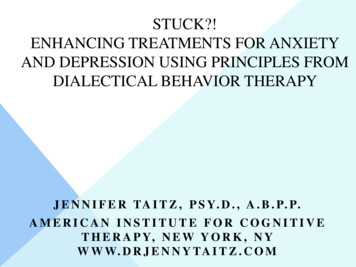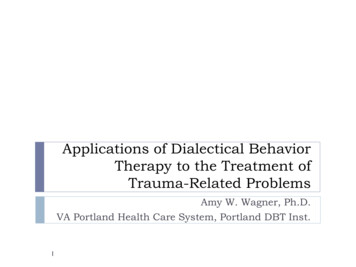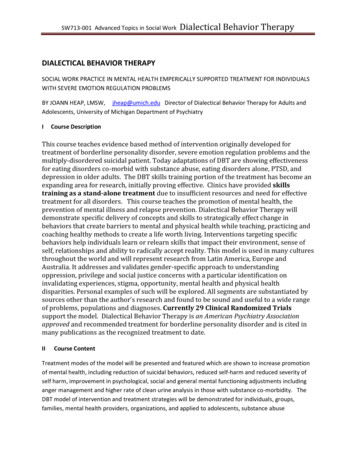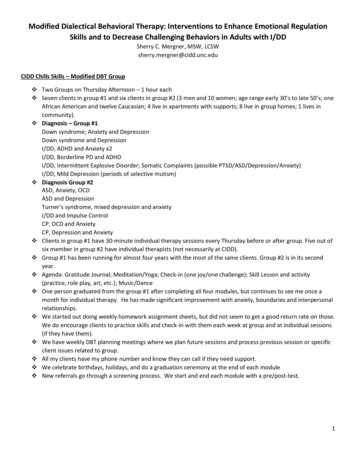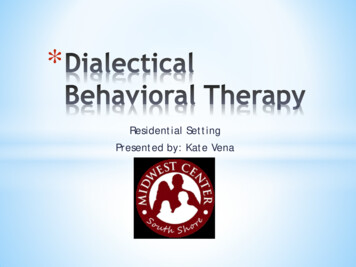
Transcription
*Residential SettingPresented by: Kate Vena
* Dialectical behavioral therapy was developedby Marsha M. Linehan.* Originally created for young, adult woman whosuffered from Borderline Personality disordersand suffered from chronic suicidal tendencies.*
* Marsha Linehan’s studies* Acceptance-oriented skills and change-orientedskills*
* Dialectical: Acceptance and change. It’s abalance.* Example: “You have the right to kill yourself;however, I have the right to save you.”*
* Sequence of events of thoughts, behaviors, andfeelings that led to destructive behaviors* Focusing on highest target problem behaviors* Learn to become more responsive rather thanreactive to situations*
* Mindfulness* Interpersonal effectiveness* Emotion regulation* Distress tolerance* Walking the middle path*
* DBT is primarily used for Borderline personalitydisorder and/or traits* Substance abuse* Eating disorders* Mood disorders* ADHD* Depression and anxiety*
* Panic attacks* Substance abuse* Family conflict* Avoidance of social situations (school included)* Suicide attempts and ideations* Self-harming behaviors* Aggression* Eating disordered behaviors*
* Core mindfulness* Distress tolerance and acceptance*
* Behaviors to increase:* Being aware of emotions* Tolerating destructive behaviors* Decrease emotional intensity* Increase the ability to concentrate* Increase the ability to bring yourself back tofocus* Sense of calm*
* Here and now* Fully aware of your experience with a nonjudgment stance* Taking control of your mind*
* Reasonable mind (logical thinking)* Emotion mind (emotional experience)* Wise mind (intuitive knowledge to reason andemotion)*
*“What skills”* Observe: notice your surroundings, thoughts,and feelings, without judgment* Describe: using words to describe youremotions and thoughts* Participate: engage in the experiencewithout judgment*
*“How skills”* Nonjudgmentally: accepting emotions forwhat they are, fact on what is there* One-mindfully: focusing on one feeling,emotion, thought, event at a time* Effectively: doing your best, settingconcrete goals*
*Moment to pause: allowingyourself to step away from a stimulatingsituation* Helps to better assess the situation* Notice the environment as well as emotionsthat you are experiencing*
*Square breathing: allows oxygen toyour brain and relaxes your muscles* Take four seconds of breath in, hold for fourseconds, release the breath for four second,repeat 4x*
* Behaviors to increase:* Managing difficult situations without destroyingself-worth, goals, and relationships* Increase the ability to self-soothe* Accepting reality*
* Learning how to manage overwhelmingemotions and situations* Can be physical and/or emotional*
*Self-soothe: 5 senses* Sight: noticing the sky* Sound: listening to calming music* Touch: petting an animal* Taste: sour candy* Smell: aromatherapy*
*Radical acceptance:acknowledge the current situation that iscausing distress without judgment* Notice or what it is* Letting go of things you cannot control*
*Distraction: aids away from selfdefeating behaviors* Write negative emotions on a balloon and popit* Take a frozen orange and notice the coldness,smell, and texture*
* Emotion regulation* Interpersonal effectiveness*
* Behaviors to Increase:* Why we experience emotions* Being aware of vulnerabilities* Being aware of triggers* Increases positive emotions* Changing emotional responses*
* Emotions: body sensations that are experience* Gain control over your emotions* Being able to change emotional responses andvulnerabilities*
* Primary emotions: initial reaction to what ishappening (fear of seeing a spider)* 9 primary emotions* Secondary emotions: emotional reactions tothe primary emotion (screaming and runningaway from the spider due to fear)*
* Reducing vulnerabilities: PLEASE skill* Treating PhysicaL illness* Balance Eating* Avoid mood-altering drugs (non-prescribed)* Balanced Sleep* Exercise*
* Reducing vulnerabilities: ABC skill* A: Accumulate positive (identify positiveexperiences in your life)* B: Build mastery: feeling confident about atalent or ability* C: Cope ahead: identify future crisis situationsand role play on how to manage this*
* Changing emotional responses:* Opposite action: do the opposite action to theemotion experienced* Example: Intense anger and wanting to bephysically aggressive. Opposite action would beto lay down and take deep breaths.*
* Behaviors to increase:* Asking for what one wants skillfully* Keeping healthy relationships* Keeping self-respect* Applying effective social skills*
* Being able to assert yourself* Social skills training* Listening skills training* Being able to say NO and negotiating conflictwithout damaging a relationship*
* GIVE skills: helping to maintain healthyrelationships* G: Be gentle (in approach)* I: Act interested (in the conversation orsituation)* V: Validate (making eye contact,acknowledging other’s emotions)* E: Easy manner (in approach)*
* FAST skills: help with maintaining self-respect* F: Be fair (with yourself, no judging)* A: Avoid apologies (mean the apology, don’tapologize if it is not sincere)* S: Stick to values (values we were raised with,no lying, stealing, etc.)* T: Be truthful (be honest with yourself)*
* Four Horseman: Identify four destructivebehaviors that you bring into relationships* We all have them!* For example: Isolating, self-harming behaviors,aggression, drug and alcohol abuse, OCDtendencies* Allows each member to take accountability fortheir behaviors*
* Thinking and acting dialectically* Avoid black and white thinking, avoiding “all ornothing” statements* Middle path is the balance betweenacceptance and change* Nothing stays the same; change will happen.*
* Using “I feel ” statements. Acceptaccountability for your feelings. State the fact.* Do not assume* Find a middle path between normalizingbehaviors versus pathology behaviors*
*Validate yourself and others* Validate by acknowledging your feelingswithout judgment* Reassure yourself that what you are feeling isimportant* It is about letting the other person know youunderstand them*
* Integrating Walking the middle path inindividual, family, and group sessions* Encouraging residents to provide validations tothemselves, peers, and families* Encourage families to practice and utilizevalidations and dialectical thinking duringsessions*
* It is important for families to be involved intreatment.* When completing a crisis survival network androle playing situations for “cope ahead”,children rely on parent involvement for supportwhen they are struggling with emotions.*
* At our facilities, we provide DBT parent classesfor families.* Classes are held every Saturday and Sundaywith visitation to follow.* Families will learn the same module and skillsas their child did.*
* Upon admission, families receive a DBTworkbook similar to their child’s* We want to be able to provide as mucheducation and information to the families!*
* Individual sessions are held weekly* Family sessions are held weekly (can be donein-person, by teleconference, or by our HIPPAcompliant Skype system)*
* It is important to us that when your childtransitions home, you will be able to speak thesame DBT language as your child.* Example: If your child is becoming stimulatedwhile in a grocery store and is beginning todeep breathe; you will acknowledge that theyare practicing square breathing.*
* DBT is about having a life worth living!* Our multi-disciplinary treatment teamintegrates DBT throughout programming(teachers, nurses, behavioral health workers,therapists, and psychiatrists)*
* We have found DBT to be successful with thepopulations and diagnosis we treat!* Residents are able to educate their peers, self,and families with the skills provided.* We educate residents on DBT coping skills andthen have them practice it during their time inour program*
* It is important for each individual to go througheach module.* Each module is broken down into therapy ledgroups that will help the resident’s not onlylearn the skills but are taught on how topractice them.*
* The modules are a week long; therefore thelength of stay preferred is 45-60 days oftreatment.* This aids in their education and understandingof each module.* Resident’s are tested on their skills knowledgeper module*
* Resident’s may require a second rotationthrough the DBT modules to help strengthentheir skills* Therapy-interfering behaviors may causeresident’s to have a more difficult timeimplementing the skills* Our staff are here for 24/7 skills coaching!*
* If you or someone you know is looking for aDialectical Behavioral Therapy Residentialtreatment center, please look at our website.* We accept ages 6-20, male and female* www.midwest-center.com* Any further questions: katie.vena@uhsinc.com*
Dialectical behavioral therapy was developed by Marsha M. Linehan. * Originally created for young, adult woman who suffered from Borderline Personality disorders and suffered from chronic suicidal tendencies. *
